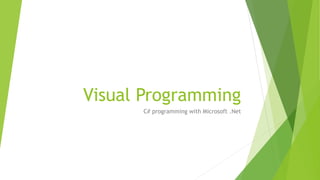
VP-303 lecture#9.pptx
- 1. Visual Programming C# programming with Microsoft .Net
- 2. C# - Classes When you define a class, you define a blueprint for a data type. This does not actually define any data, but it does define what the class name means. That is, what an object of the class consists of and what operations can be performed on that object. Objects are instances of a class. The methods and variables that constitute a class are called members of the class. A class definition starts with the keyword class followed by the class name; and the class body enclosed by a pair of curly braces. Following is the general form of a class definition −
- 3. C# - Classes <access specifier> class class_name { // member variables <access specifier> <data type> variable1; <access specifier> <data type> variable2; <access specifier> <data type> variableN; // member methods <access specifier> <return type> method1(parameter_list) { // method body } <access specifier> <return type> method2(parameter_list) { // method body } <access specifier> <return type> methodN(parameter_list) { // method body } }
- 4. C# - Classes Access specifiers specify the access rules for the members as well as the class itself. If not mentioned, then the default access specifier for a class type is internal. Default access for the members is private. Data type specifies the type of variable, and return type specifies the data type of the data the method returns, if any. To access the class members, you use the dot (.) operator. The dot operator links the name of an object with the name of a member.
- 5. C# - Namespaces A namespace is designed for providing a way to keep one set of names separate from another. The class names declared in one namespace does not conflict with the same class names declared in another. A namespace definition begins with the keyword namespace followed by the namespace name as follows − namespace namespace_name { // code declarations }
- 6. C# - Namespaces To call the namespace-enabled version of either function or variable, prepend the namespace name as follows − namespace_name.item_name; The following program demonstrates use of namespaces − using System; namespace first_space { class namespace_cl { public void func() { Console.WriteLine("Inside first_space"); } } }
- 7. C# - Namespaces namespace second_space { class namespace_cl { public void func() { Console.WriteLine("Inside second_space"); } } }
- 8. C# - Namespaces class TestClass { static void Main(string[] args) { first_space.namespace_cl fc = new first_space.namespace_cl(); second_space.namespace_cl sc = new second_space.namespace_cl(); fc.func(); sc.func(); Console.ReadKey(); } }
- 9. C# - Namespaces When the above code is compiled and executed, it produces the following result − Inside first_space Inside second_space
- 10. The using Keyword The using keyword states that the program is using the names in the given namespace. For example, we are using the System namespace in our programs. The class Console is defined there. We just write − Console.WriteLine ("Hello there"); We could have written the fully qualified name as − System.Console.WriteLine("Hello there"); You can also avoid prepending of namespaces with the using namespace directive. This directive tells the compiler that the subsequent code is making use of names in the specified namespace. The namespace is thus implied for the following code − Let us rewrite our preceding example, with using directive −
- 11. The using Keyword using System; using first_space; using second_space; namespace first_space { class abc { public void func() { Console.WriteLine("Inside first_space"); } } }
- 12. The using Keyword namespace second_space { class efg { public void func() { Console.WriteLine("Inside second_space"); } } }
- 13. The using Keyword class TestClass { static void Main(string[] args) { abc fc = new abc(); efg sc = new efg(); fc.func(); sc.func(); Console.ReadKey(); } }
- 14. The using Keyword When the above code is compiled and executed, it produces the following result − Inside first_space Inside second_space
- 15. Nested Namespaces You can define one namespace inside another namespace as follows − namespace namespace_name1 { // code declarations namespace namespace_name2 { // code declarations } }
- 16. Nested Namespaces You can access members of nested namespace by using the dot (.) operator as follows − using System; using first_space; using first_space.second_space; namespace first_space { class abc { public void func() { Console.WriteLine("Inside first_space"); } } namespace second_space { class efg { public void func() { Console.WriteLine("Inside second_space"); } } } }
- 17. Nested Namespaces class TestClass { static void Main(string[] args) { abc fc = new abc(); efg sc = new efg(); fc.func(); sc.func(); Console.ReadKey(); } }
- 18. Nested Namespaces When the above code is compiled and executed, it produces the following result − Inside first_space Inside second_space